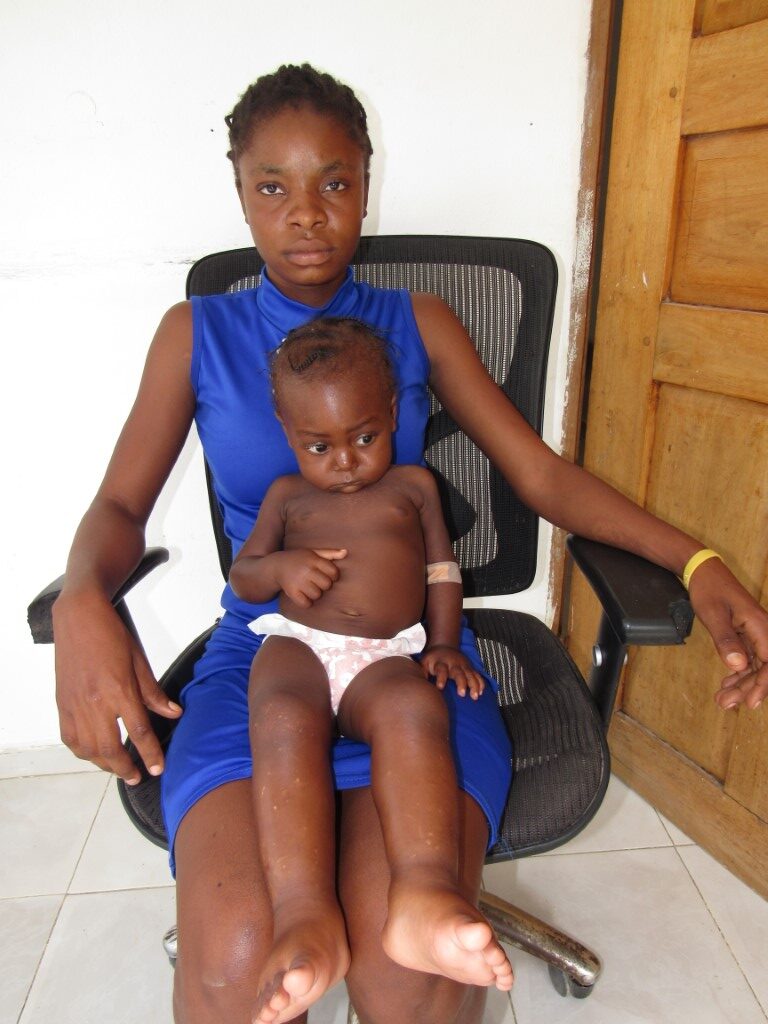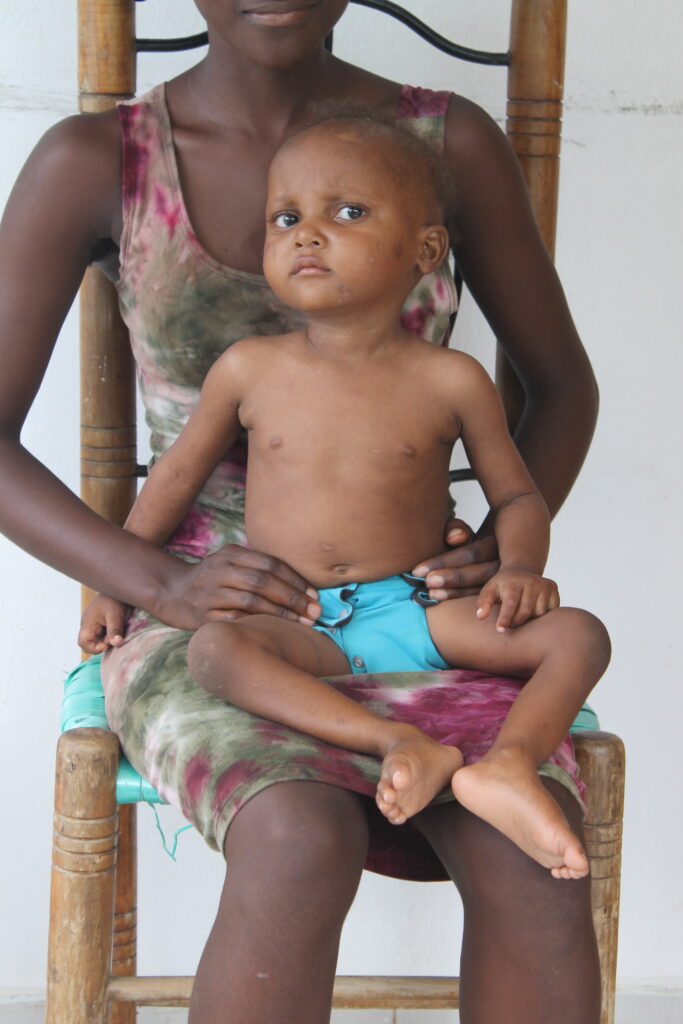Nini was brought to the clinic by her parents, both farmers, after experiencing a persistent fever, diarrhea, and cough for a month. The diagnosis revealed that Nini had edema from kwashiorkor. Nini is one of four sisters, as her brothers had passed away. Nini’s family lives in a four-room house made of rocks and clay, with a tin roof. However, they have no access to running water or a toilet, not even an outhouse. They must walk 30 minutes to the nearest water source and walked two hours to reach the clinic. Sadly, Nini’s malnutrition is severe, with a -4 standard deviation and kwashiorkor. She was gien the F-75 therapeutic milk and later transitioned to medika mamba.
Guivelande was brought to the clinic by her father, who had been away in the Dominican Republic for several months. Despite living with her mother, she was suffering from edema caused by kwashiorkor. Guivelande only has one sister and no living brothers. Her parents work as farmers, growing millet, beans, and corn in their gardens. These crops are then sold in open-air markets to generate income. Guivelande and her three family members reside in a two-room home made of rocks and clay, with a tin roof. They do not have running water or a flush toilet, not even an outhouse. They have to walk for about 20 minutes to collect water from a nearby source. The family traveled four hours by motorcycle to reach the clinic. Guivelande was found to be severely malnourished, with a -2 standard deviation, and was started on F-75 therapeutic milk before being moved to a medika mamba treatment.
Rolanda was brought to the clinic by her father as an outpatient for the nutritional program, but unfortunately, she showed no improvement. Due to her worsening condition, she was admitted for inpatient care. Upon admission, she was diagnosed with kwashiorkor and is considered severely malnourished with a -4 standard deviation. Rolanda has four siblings; two sisters and two brothers, but one sibling has passed away from asthma. Her mother has also passed away, and her father is a farmer who cultivates bananas, beans, and corn. They sell their crops in open-air markets to earn a living. Rolanda resides in a three-room house made of rocks and clay with her father and three other family members. The house has a tin roof, but they do not have access to running water or a flush toilet, not even an outhouse. They rely on a water source that is approximately 30 minutes away from their home. The family traveled for an hour and a half by motorcycle to reach the clinic. Rolanda was started on F-75 therapeutic milk and then moved to medika mamba to address her condition.
Padjy Idens was brought to the clinic by his aunt, presenting symptoms of kwashiorkor and a cold. He had been experiencing edema for the past month. Padjy had been living with his father, but moved in with his aunt when he fell ill. The aunt’s home, made of rocks and clay with a tin roof, is shared with nine family members and has five rooms. The family uses an outhouse and obtains water from a source that is a thirty-minute walk from their home. Padjy’s father works in the construction industry, and the family traveled on a two-hour motorcycle ride to reach the clinic. Padjy’s weight-to-height ratio is -4 standard deviations, indicating severe malnourishment, in addition to his diagnosis of kwashiorkor. He was admitted for inpatient care and given F-75 therapeutic milk before being switched to medika mamba.
Stephania was accompanied by her aunt to the clinic due to her fragile health. She was experiencing kwashiorkor, diarrhea, and a cold, along with edema that persisted for six weeks. She lives with her parents, three sisters, and a newborn sibling. Stephania’s family earns a living by farming millet, corn, and beans. They sell their crops at the open-air market to make a profit. The family resides in a one-room cinder block house with a tin roof, lacking running water and a flush toilet. Instead, they use an outhouse, and must walk thirty minutes to obtain water from the nearest source. Despite traveling on foot for five hours to reach the clinic, Stephania’s weight to height ratio was -4 standard deviations, indicating severe malnourishment, in addition to her kwashiorkor diagnosis. She received inpatient care and was provided with F-75 therapeutic milk and was later switched to medika mamba.
Wensky, accompanied by his mother, was brought to the clinic due to his poor health. His grandmother is the primary caregiver for the child. He was diagnosed with marasmus and a cold upon arrival. Wensky’s family, consisting of six members, lives in a four-room house made of rocks and clay with a tin roof. The family does not have access to running water or a flush toilet, but they do have an outhouse. They obtain their water from a piped source that is a five-minute walk away from their home. Wensky’s father works as a motorcycle taxi driver, while his mother purchases items in bulk and resells them. The family resides in the village of Cazale, near the clinic. Wensky’s
weight-to-height ratio indicates severe malnourishment, with a deviation of -4 standard deviations. He was admitted to the clinic for inpatient care and given F-75 therapeutic milk before switching to medika mamba.







